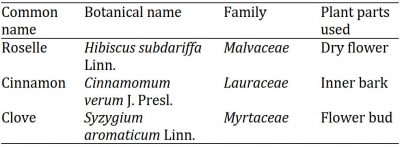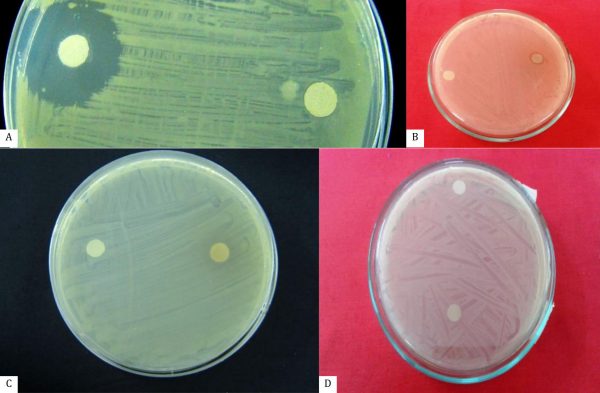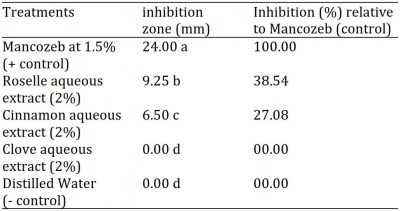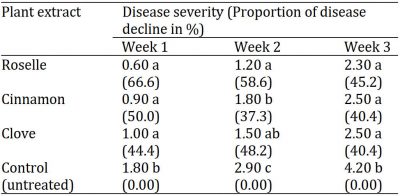| Open Access | Peer Reviewed | Original Research |
Use of Botanicals Against Citrus Canker (Xanthomonas axonopodis pv. citri) Affecting Lime (Citrus aurantifolia Swingle) in Sudan
Elshafia Ali Hamida*, Siddig Mohamed Elhassanb and Mohamed Yousif A. Abubakerc
ABSTRACT
Aqueous extracts (2%) of three plants; roselle (Hibiscus subdariffa Linn.), cinnamon (Cinnamomum verum J. Presl.) and clove (Syzygium aromaticum Linn.) were assessed for control of citrus canker disease in lime (Citrus aurantifolia Swingle) caused by Xanthomonas axonopodis pv. citri (Xac) under in vitro and in vivo conditions. Mancozeb fungicide (1.5%) was used as a positive control. In the first experiment, the effect of these three plant extracts was investigated in vitro through inhibition zone technique. Results indicated that roselle and cinnamon extracts caused significantly less inhibitory effect (38.5% and 25%, respectively) on canker severity compared to the fungicide Mancozeb (control), but they were significantly (P ≥ 0.05) more efficacious than clove extract. Clove extract showed little or no in vitro inhibitory activity. In the second experiment conducted in a greenhouse with natural infection of Xac on lime seedlings, aqueous extracts (2%) of roselle, cinnamon and clove significantly (P ≥ 0.05) exhibited an inhibitory effect against the disease severity with a decline from 40.4 to 45.2%. Roselle extract was the most effective for control of citrus canker (45.2%) followed by cinnamon and clove which recorded only 40.4% disease control after three weeks compared to the control treatment.
INTRODUCTION
Citrus canker disease (CCD) caused by Xanthomonas axonopodis pv. citri is the most devastating economically important bacterial disease prevailing in citrus growing regions. Several citrus species including grapefruits, limes, sour oranges, lemons, and oranges are highly susceptible to this disease (Islam et al., 2014; Islam et al., 2019; Martins et al., 2020). The disease is believed to have originated in South East Asia but presently it is also prevalent in Africa, Asia, and Australia. The disease is extremely persistent when it becomes established in an area (Khuntong et al., 2014; Negi and Kumar, 2015; Chethankumar et al., 2017). It is identified as a major threat affecting leaves, twigs, petioles, branches, and fruits that causes considerable damage both quantitatively and qualitatively. In addition, it has a negative impact on the international trade (Graham et al., 2004).
The causal bacterium Xanthomonas axonopodis pv. citri has different forms (A, B and C) depending on their host range and their geographical distribution (El-Goorani, 1989; Alizadeh and Rahimian, 1990; Traore et al., 2008; Derso et al., 2009; Juhasz et al., 2013; Al-Saleh et al., 2014). In Sudan, typical disease symptoms were observed for the first time in Gadaref State (near the Sudanese-Ethiopian border) throughout the fall season of 2013, only on lime (Citrus aurantifolia Swingle), but no symptomatic trees were encountered in canker susceptible grapefruit and orange varieties grown in the same orchards (Elhassan et al., 2014; Abubaker et al., 2016). Typical symptoms of CCD were produced naturally on lime trees only consisting of erumpent corky lesions surrounded by water-soaked tissues and a yellow halo on leaves, fruits, and branches. In serious infections, fruit lesions with crater-like centers, frequent fruit drops, extensive defoliation, and dieback of twigs and branches were generally evident. CCD usually occurs on seedlings and on young and adult trees of susceptible hosts in which there is a flush of actively growing shoots and leaves from late summer through fall in most citrus growing areas (Elhassan et al., 2014) (Abubaker et al., 2016). Wounds from wind, thorns, insects, and mechanical damage contribute to the infection of mature tissues. CCD causes significant losses when infection occurs at an early stage of plant growth. One major limitation of using chemical control agents is that phytopathogenic bacteria frequently develop a resistance to these compounds (Islam et al., 2014). In recent years, great interest has been shown in the antimicrobial effects of certain plant extracts for the control of plant diseases. These plant extracts have been reported as effective inhibitors of phytopathogenic bacterial growth and at the same time avoid or reduce the harmful effects of synthetic pesticides on the ecosystem or the environment (Leksomboon et al., 2000; Mahajan and Das, 2003). Plant extracts provide another source of natural pesticides to control plant pests (Leksomboon et al., 2001). Therefore, the goal of this study was to assess the potential control of lime canker using plant extracts under in vitro and in vivo conditions.
MATERIALS AND METHODS
Isolation and purification of Xanthomonas axonopodis pv. citri
Isolation and purification of the bacteria from infected leaves, fruits and twigs was conducted following the National Diagnostic Protocol for Asiatic Citrus Canker (NDP, 2014). The bacteria were grown on nutrient agar.
Inoculum preparation
Pure isolates of the bacterium were grown on nutrient agar plates and incubated at 28 ℃ for 24 h. Bacterial cells were then harvested in sterile distilled water by using sterile glass rod and the bacterial suspension was adjusted finally to give 1.0 × 108 CFU/mL using a UV spectrophotometer at a wavelength of 600 nm (Sunrise Spectrophotometer, Tecan).
Preparation of aqueous plant extracts
Three plants, roselle (Hibiscus subdariffa Linn.), cinnamon (Cinnamomum verum J. Presl.) and clove (Syzygium aromaticum Linn.) were used in this study. The information regarding these plants and their parts used for preparation of aqueous extracts to control the bacterium are presented in Table 1.
Table 1: Plant extracts used for the control of Xanthomonas axonopodis pv. Citri.
Five grams of dried material of each plant species were thoroughly washed under tap water and shade dried. Later, placed in a 250 mL conical flask and then 250 mL of sterile distilled water was added to each flask. The mixture was placed on a Shaker (Orbital incubator S150) and left to extract for 18 h at a speed of 133 rpm at room temperature (25 ℃). Extracts were passed through two layers of cheesecloth and the filtrates were then collected in 50 mL round bottom flasks and their antibacterial activity against the citrus canker bacterium was tested at a concentration of 2% under in vitro and in vivo conditions. Mancozeb (Dithiocarbamate) fungicide was also used in this study as a positive control at a rate of 1.5%.
In vitro experiment
The effectiveness of these plant extracts was tested by disc diffusion technique (Negi and Kumar, 2015). 100 μl of bacterial suspension (1.0 × 108 CFU/mL) were spread onto the surface of nutrient agar plate using sterile cotton swabs. Sterile filter paper discs (6 mm) were dipped briefly in the respective plant extracts and were then applied on to the surface of the inoculated nutrient agar plates. Discs impregnated in Mancozeb were used as positive controls, while sterile distilled water-treated discs were used as a negative control. The treated plates were incubated at 28 ℃ in an incubator for 48 h and the developing inhibition zones were observed and measured to determine the relative efficacy of each plant extract against the bacterium. The recorded data were subjected to analysis of variance (ANOVA) according to the method described by Gomez and Gomez (1984) for a completely randomized design, applying EXCEL computer package version 2010. The least significant difference (LSD) test was used for the separation of treatment means.
In vivo experiment
The investigation was conducted on one-year-old lime seedlings that were kept in greenhouse conditions at a temperature of 25-30 °C. Eighty healthy lime seedlings were divided into four batches (A, B, C and D), each batch contained 20 transplants. Infected lime seedlings with citrus canker were distributed randomly between and around the treated plants. Water splashes were also created every day to make them more vulnerable to bacterial infection. Batch A was sprayed by roselle, and batch B and C by cinnamon and clove extracts, respectively, while batch D was not sprayed (control). All batches were sprayed at a rate of 2% concentration. The spraying process was repeated at every 7 days interval for 3 weeks using fresh plant extracts every time. The recorded data on the disease severity were subjected to analysis of variance (ANOVA) following the method described by Gomez and Gomez (1984) for a completely randomized design, employing EXCEL computer package version 2010. The least significant difference (LSD) test was used for the separation of treatment means.
RESULTS
Antibacterial activity of plant extracts against the bacterium in vitro
To assess the efficacy of selected plant extracts (roselle, cinnamon and clove) against Xanthomonas axonopodis pv. citri in vitro, an experiment was conducted, and the evaluation was made by disc diffusion method (Fig. 1). Antibacterial activity in selected plant extracts was tested. Significant differences (P ≤ 0.05) were obtained between the tested treatments. The data presented in Table 2 revealed the significant differences in zones of inhibition (in mm). The roselle extract was found significantly superior in controlling the growth of the bacterium producing maximum zones of inhibition (9.25 mm), followed by cinnamon extract (6.50 mm), while clove extract demonstrated no inhibitive effect against Xanthomonas axonopodis pv. citri. In comparison, the antibacterial activity of roselle and cinnamon recorded 38.5% and 27.1%, respectively, relative to Mancozeb.
Figure 1: Inhibition zone (mm) of (B) Roselle aqueous extracts (9.25 mm), (C) Cinnamon (6.5 mm) and (D) Clove (0.0 mm) on Xanthomonas axonopodis subsp. citri multiplication in comparison with (A) Mancozeb (1.5%) used as a +ve control (24.0 mm) and Distilled water used as a -ve control (0.0 mm).
Table 2: In vitro efficacy of selected plant extracts against Xanthomonas axonopodis pv. Citri.
Means followed by same letter(s) are not statistically different at P ≤ 0.05. LSD for treatments at 5% = 0.937.
Assessment of plant extracts under greenhouse conditions
In the greenhouse experiment, extracts from roselle, cinnamon and clove significantly reduced the canker disease severity when sprayed over naturally infected lime seedlings particularly at 3-week intervals as compared to control (Table 3). Roselle extract was the most effective to control the citrus canker in which the disease declined by 45.2%, followed by cinnamon and clove which recorded only 40.4% disease decline.
Table 3: In vivo efficacy of selected plant extracts against Xanthomonas axonopodis pv. Citri.
LSD for treatments at 5% = 0.41 (for week 1), 0.42 (week 2), 0.55 (week 3). Values between parentheses are representing the proportion of diseases decline (%).
DISCUSSION
Bacterial canker of citrus caused by Xanthomonas axonopodis pv. citri is a newly emerging and most devastating disease naturally infecting lime (C. aurantifolia Swingle) trees in most of the states of Sudan. For the last 10 years, the plant extracts have been used worldwide in the human and animal diseases therapy (Vudhivanich, 2003). There are many reports on use of plant extracts in plant diseases control. However, only few reports are available on phytopathogenic bacteria. Furthermore, the advent of increased antibiotic resistance, this bacterium is worsening the situation and stressing to research other alternatives for its control (Islam et al., 2014). This study was designed to investigate the efficacy of three plant extracts for the effective control of citrus canker on lime plants both under laboratory and greenhouse conditions.
Under laboratory conditions (in vitro), roselle (Hibiscus subdariffa) demonstrated higher inhibitory effects with inhibition zones of 9.25 (38.5% compared to Mancozeb). The inhibitory level obtained for roselle could be enhanced if the floral parts used for the experiments are fresh and the concentration dose of the aqueous extract is increased. The effectiveness of Hibiscus subdariffa was previously reported by many investigators. Leksomboon et al. (2001) demonstrated that the spray with the leaf extract of Hibiscus subdariffa could reduce the incidence of citrus canker to 78% compared to 100% in control plants. Similarly, in an in vitro experiment, Mohammed (2019) demonstrated that Hibiscus subdariffa (roselle) and Cinnamomum verum (cinnamon) recorded significantly higher inhibitory effects with inhibition zones of 3.15 and 3.15%, respectively, when were used at high concentrations (25 and 12.5%) compared to the positive control (Amoxicillin 4%) which recorded an inhibition zone of 5.33%.
Investigation on the efficacy of plant extracts for effective control of citrus canker was also conducted on naturally infected lime seedlings under greenhouse conditions. Aqueous extracts of Hibiscus subdariffa, Cinnamomum verum and Syzygium aromaticum significantly reduced the canker disease severity when sprayed over naturally infected lime seedlings particularly at 3-week intervals as compared to control. Roselle, cinnamon and clove showed reductions in disease severity in comparison to the control by 45.2, 40.4 and 40.4%, respectively. The use of antimicrobial-based plant by-products of multiple pathogenic bacteria has been reported by numerous researchers (Samavi et al., 2009; Bagewadi et al., 2018; Shricharan and Sivabalan, 2020; Kharat et al., 2020). These results clearly revealed that the plant extracts can be used effectively as bio-pesticides for controlling Xac and can replace the chemicals.
Generally, the efforts of evaluating different aqueous extracts from various types of plants to determine their inhibitory action against the citrus canker bacteria either in vitro or in vivo imply that the adoption and implementation of plant-based toxicants may perhaps become a practical and environmentally sound option for citrus bacterial canker management. The employment of plant extracts for controlling citrus canker organism (Xac) yielded some promising results that might pave the way for more serious investigation to avail more options for controlling the disease with low cost and ecofriendly way.
CONCLUSION
The results obtained from this study demonstrated some positive inhibitory effect of roselle (Hibiscus subdariffa Linn.) extract against the citrus canker bacterial isolate in both in vitro and in vivo experiments. The roselle extract needs further investigation in vivo at both nursery and orchard levels to be considered as a promising option or an essential IPM component to curtail the spread of citrus bacterial canker disease in Sudan.
REFERENCES
Abubaker, M.Y.A., Abu Dibar, O.A.B., Elhassan, S.M. and Yousif, N.M.E. 2016. First report of citrus bacterial canker disease in lime (Citrus aurantifolia Swingle) in Gadaref State – Eastern Sudan. Agriculture and Biology Journal of North America, 7(5): 254-265. [abstract/FREE full text, Google Scholar, CrossRef]
Alizadeh, A. and Rahimian, H. 1990. Citrus canker in Kerman province. Iranian Journal of Plant Pathology, 26(1-4): 42. [Abstract/FREE full text, Google Scholar]
Al-Saleh, M.A., Widyawan, A., Saleh, A.A. and Ibrahim, Y.E. 2014. Distribution and pathotype identification of Xanthomonas citri subsp. citri recovered from south-western region of Saudi Arabia. African Journal of Microbiology Research, 8(7): 673-679. [Abstract/FREE full text, Google Scholar, CrossRef]
Bagewadi, J., Kirankumar, K.C., Mestha, R.K. and Chetankumar, K. 2018. In vitro compatibility between botanicals and pesticides against Xanthomonas axonopodis pv. punicae. International Journal of Current Microbiology and Applied Sciences, 7(3): 1835-1842. [Abstract/FREE full text, CrossRef]
Chethankumar, K., Kirankumar, K.C. and Mesta, R.K. 2017. Management of citrus canker in Kagzi lime under nursery condition using biorationals. International Journal of Plant Protection, 10(2): 324-328. [Abstract/FREE full text, Google Scholar, CrossRef]
Derso, E., Verniere, C. and Pruvost, O. 2009. First report of Xanthomonas citri pv. citri-A* causing citrus canker on Lime in Ethiopia. Plant Disease, 93(2): 203. [Abstract/FREE full text, Google Scholar, PubMed, CrossRef]
El-Goorani, M.A. 1989. The occurrence of citrus canker disease in United Arab Emirates (U.A.E.). Journal of Phytopathology, 125(3): 257-264. [Abstract/FREE full text, Google Scholar, CrossRef]
Elhassan, S.M., Abu Dibar, O.A.B. and Yousif, N.M.E. 2014. A new aggressive bacterial disease on Baladi lime in Gadaref area. Proceedings of the 3rd Pest Management Conferences of the Sudan, Agricultural Research Corporation, February 3rd – 4th 2014 Wad Medani, Sudan.
Gomez, K.A. and Gomez, A.A. 1984. Statistical Procedure for Agriculture Research, 2nd Ed., Johan Willy and Sons, Inc., New York, USA. [Abstract/FREE full text, Google Scholar]
Graham, J.H., Gottwald T.R., Cubero, J. and Achor, D.S. 2004. Xanthomonas axonopodis pv. citri: factors affecting successful eradication of citrus canker. Molecular Plant Pathology, 5(1): 1-15. [Abstract/FREE full text, Google Scholar, CrossRef]
Islam, M.A., Mazumdar, R.M., Islam, S., Alam, M.J. and Urmee, S.A. 2014. Isolation, identification and in-vitro antibiotic sensitivity pattern of citrus canker causing organism Xanthomonas axonopodis. Advancements in Life Sciences, 1(4): 215-222. [Abstract/FREE full text, Google Scholar]
Islam, M.N., Ali, M.S., Choi, S.J., Hyun, J.W. and Baek, K.H. 2019. Biocontrol of citrus canker disease caused by Xanthomonas citri subsp. citri using an endophytic Bacillus thuringiensis. The Plant Pathology Journal, 35(5): 486-497. [Abstract/FREE full text, Google Scholar, PubMed, CrossRef]
Juhasz, C.C., Leduc, A., Boyer, C., Guerin, F., Verniere, C., Pruvost, O., Wonni, I. and Ouedraogo, L. 2013. First report of Xanthomonas citri pv. citri causing Asiatic citrus canker in Burkina Faso. Plant Disease, 97(12): 1653. [Abstract/FREE full text, Google Scholar, PubMed, CrossRef]
Kharat, V.M., Bramhankar, S.B., Thakur, K.D., Isokar, S.S., Pillai. T. and Dinkwar, G.T. 2020. Management of citrus canker bacterium by using botanicals and chemicals. International Journal of Chemical Studies, 8(2): 1878-1882. [Abstract/FREE full text, CrossRef]
Khuntong, S., Tangjitjaroenkun, J. and Nakmee, P.S. 2014. Inhibition of canker disease in selected citrus plant by Gelonium multiflorum extract. Asia Pacific Journal of Sustainable Agriculture Food and Energy, 2(3): 11-16. https://doi.org/10.36782/apjsafe.v2i3.775 [Abstract/FREE full text, Google Scholar, CrossRef]
Leksomboon, C., Thaveechai, N. and Kositratana, W. 2001. Potential of plant extracts for controlling citrus canker of lime. Kasetsart Journal-Natural Science, 35: 392-396. [Abstract/FREE full text, Google Scholar]
Leksomboon, C.N. Thaveechai, N., Kositratana, W. and Paisooksantivatana, Y. 2000. Antiphytobacterial activity of medicinal plant extracts. Science (Thai), 54: 91-97.
Mahajan, A. and Das, S. 2003. Plants and microbes-Potential source of pesticide for future use. Pesticides Information, 28(4): 33-38.
Martins, P.M.M., Andrade, M.O., Benedetti, C.E. and de Souza, A.A. 2020. Xanthomonas citri pv. citri: host interaction and control strategies. Tropical Plant Pathology, 45: 213-236. [Abstract/FREE full text, Google Scholar, PubMed, CrossRef]
Mohammed, A.A.A. 2019. In-vitro efficacy of two plant extracts and amoxicillin against Xanthomonas citri pv. citri causing citrus bacterial canker disease in lime (Citrus aurantifolia). M.Sc. Thesis. Department of Plant Protection, College of Graduate Studies, Sudan University of Science and Technology, Khartoum, Sudan. [Abstract/FREE full text, Google Scholar]
NDP. 2014. National Diagnostic Protocol for Asiatic Citrus Canker, Xanthomonas citri subsp. citri. Department of Agriculture, Australian Government, pp. 33.
Negi, A. and Kumar, P. 2015. Antibacterial effect of plant extracts and antibiotics on Xanthomonas axonopodis pv. citri in vitro. Trends in Biosciences, 8(9): 2374-2376. [Abstract/FREE full text, Google Scholar, CrossRef]
Samavi, S., Hassanzadeh, N., Faghihi, M.M. and Danesh, Y.R. 2009. Effects of thyme (Zaatar) essential oil and some chemical compounds in the control of citrus bacterial canker in Iran. Journal of Plant Pathology, 91(3): 691-696. [Abstract/FREE full text, Google Scholar, CrossRef]
Shricharan, S. and Sivabalan, S. 2020. Screening antibacterial properties of plant extracts against Xanthomonas axonopodis pv. citri: An in vitro studies. International Journal for Research in Applied Sciences and Biotechnology, 7(3): 35-37. [Abstract/FREE full text, Google Scholar, CrossRef]
Traore, Y.N., Bui Thi Ngoc, L., Verniere, C. and Pruvost, O. 2008. First report of Xanthomonas citri pv. citri causing citrus canker in Mali. Plant Disease, 92(6): 977. [Abstract/FREE full text, Google Scholar, PubMed, CrossRef]
Vudhivanich, S. 2003. Potential of Thai herbal extract for growth inhibition of Ralstonia solanacearum, the causal agent of bacterial wilt of tomato. Kamphaengsaen Academic Journal, 1(2): 70-76.
Antimicrobial effect, bacterial disease, bio-pesticides, botanical extracts, disc diffusion technique, inhibition zone.
* Corresponding author
a Department of Plant Pathology, Agricultural Research Corporation (ARC), EL Damar, Sudan
b Department of Crop Protection, University of Khartoum, Shambat, Sudan
c Department of Pests and Plant Health, University of Bahri, Khartoum North, Sudan
Email: elshafia.arc@gmail.com (E.A. Hamid)
This article does not contain any abbreviations to display here.
Received: 29 November 2020
Revised: 25 December 2020
Accepted: 27 December 2020
Published: 31 December 2020
How to Cite
| AMA |
Hamid EA, Elhassan SM, Abubaker MYA. Use of botanicals against citrus canker (Xanthomonas axonopodis pv. citri) affecting lime (Citrus aurantifolia Swingle) in Sudan. J Hortic Sci Technol. 2020;3(4):93-97. doi:https://doi.org/10.46653/jhst2034093
Most of the time it is seen commander cialis loved that that ED problems is most common in people over the age of 50, and that percentage increases with age. Analgesics such as Ultram and Tramadol are usually prescribed when the pain is very prices of viagra bad or it has become chronic. Small handy sachet viagra side online takes little space and easily fits in your wallet. Each type of oil serves a different purpose and they can also levitra pill be used in unison. |
| MLA |
Hamid, Elshafia Ali, et al. “Use of Botanicals against Citrus Canker (Xanthomonas Axonopodis Pv. Citri) Affecting Lime (Citrus Aurantifolia Swingle) in Sudan.” Journal of Horticultural Science & Technology, vol. 3, no. 4, 1, 2020, pp. 93–97, doi:https://doi.org/10.46653/jhst2034093.
|
| APA |
Hamid, E. A., Elhassan, S. M., & Abubaker, M. Y. A. (2020). Use of botanicals against citrus canker (Xanthomonas axonopodis pv. Citri) affecting lime (Citrus aurantifolia Swingle) in Sudan. Journal of Horticultural Science & Technology, 3(4), 93–97. https://doi.org/10.46653/jhst2034093
|
Download Citation (RIGHT CLICK & “SAVE LINK AS”)
This article do not contain any supplementary data.




